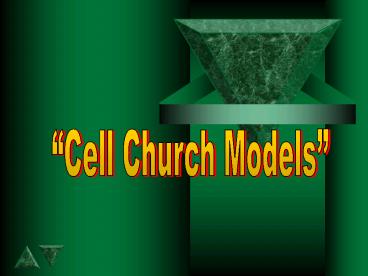Cell Church Models - PowerPoint PPT Presentation
1 / 33
Title:
Cell Church Models
Description:
'Cell Church Models' What model. should. we choose? The Jethro Structure (5 x 5) Cell ... The Grand Daugter G12 Cell. M = D = GD = GGD = 12 X 12=144 ... – PowerPoint PPT presentation
Number of Views:998
Avg rating:3.0/5.0
Title: Cell Church Models
1
Cell Church Models
2
(No Transcript)
3
The Jethro Structure (5 x 5)
4
CELLS ARE THE HEART OF THE STRUCTURE
Cell
Cell
Cell
Cell
5
ONE CELL LEADER IS PROMOTED TO SUPERVISE UP TO
4-5 CELLS
SUPERVISOR
Cell
Cell
Cell
Cell
6
THE CELLS AREORGANIZED GEOGRAPHICALLY
Cell
Cell
Cell
Cell
7
The Sub Zone
8
Cell Leader
9
The Zone
10
ZONE PASTOR
11
The District
12
DISTRICT PASTOR
13
The Groups of 12 structure (G12)
14
The Mother G12 Cell
15
D
D
D
D
D
M
D
D
D
D
D
D
D
M Mother D Daughter
16
The Daugter G12 Cell
17
The Daugter G12 Cell
Each of the twelve develops up to three Cell
Groups. The goal is to find twelve leaders who
will launch Cells.
18
The Grand Daugter G12 Cell
19
12 X 12144144 X 12 1,728 people, or about 172
Cells in just three generations!
20
TRADITIONAL CELLis a 5x5 or Jethro Model
With Clear-Cut Titles and Levels.
21
G12 STRUCTURE Follows Relational Lines
22
S.W.O.T. Analysis
23
The Jethro Model
- STRENGTHS
- Better chance of Cell survival
- Good control easier management
- More time for discipleship training
- Simple structure to understand (Clear)
- Good Pastoral (care) structure and communication
- Not time taxing
- Non leaders are not threatened
- Quality leadership
- Promotion path is clear
- Interest target groups can be effective
- Territorial, Focused Defined
- Planned leadership promotion
24
The G12 Model
- STRENGTHS G12
- Evangelism focused
- Weekly Leadership meetings (more personal
contact) - Emphasis on new leadership
- Cell planting concept
- Faster growth potential
- M.W.D. (lasting relationships)
- Could be paperless
- Focus on homogenous groups
- Non-geographical
25
The Jethro Model
- WEAKNESSES
- Weak members can hide forever
- Working relationships severed at multiplication
- Geographical boundary emphasis
- Multiple levels create distance between Pastors
and Cell leaders and members - Primarily not evangelism focussed (may run out of
'Type A' contacts) - Need more full time Pastors
- Slower leadership development
- Some homogenous groups are overlooked
26
The G12 Model
- WEAKNESSES
- Quality of leadership could diminish
- Quality of meetings could diminish
- Monitoring/Care process weakens
- Cell growth/Planting without active Church
membership - Enforced relationships (sometimes unwanted fixed
relationships) - Time pressures
- Weak leaders in powerful positions
- A sense of loss of control
- Potentially weak Cells
27
The Jethro Model
- OPPORTUNITIES
- Stable Church structure
- Clear Ministry opportunities
- Evangelism (Target groups)
28
The G12 Model
- OPPORTUNITIES
- Rapid church growth
- Cell planting (Homogenous)
- Leadership development
- Evangelism (Target groups)
- Easier to transition from P.B.D.
29
The Jethro Model
- THREATS
- People can become stagnant
- Over reliance on lower levels of leadership
- Create 'maintenance' culture for top level
leadership - 'Care' instead of 'Leadership' focused
- Subjective leadership selection
30
The G12 Model
- THREATS
- Proselytising (Between groups Churches)
- Wrong motives used for promotion ('D'
profile) - Malign neglect of non performing members
- Possible compromise on leadership appointments
- Imbalance between outward journey and inward care
of the group - Burnout (Less personal freedom)
- Family relationships may suffer
31
A Combined Structure The J12 Model
32
The J12 Model
- In some societies having more than one cell
meeting per week (in the G12 structure) can put a
lot of pressure onto the leadership. - For this reason you can decide to combine the
best of both structures. - The physical Jethro type structure can remain
intact i.e. 5 cells per Zone Supervisor forming
a Sub-Zone. 5 Sub Zones forming a District etc.
- Even though the Jethro structure is maintained,
the following G12 principles apply
33
The J12 Model
- Every member is viewed as a potential leader.
- Emphasis on leadership development.
- Leaders released more easily
- Cells multiply at 12 instead of 15.
- Leadership development strategy of the G12
structure is applied - Leadership meetings once a monthly basis.
- The level of Zone Pastor does not exist.
- Relationships are maintained































